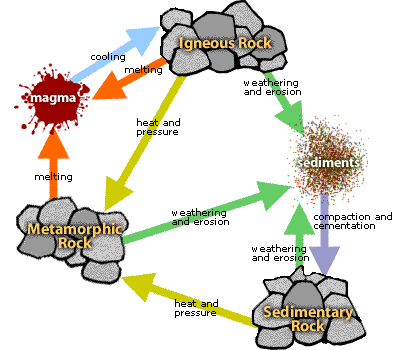The Rock Cycle is a group of changes. Igneous rock can change into sedimentary rock or into metamorphic rock. Sedimentary rock can change into metamorphic rock or into igneous rock. Metamorphic rock can change into igneous or sedimentary rock.



Although rock climbing was an important component of Victorian mountaineering in the Alps, it is generally thought that the sport of rock climbing began in the last quarter of the nineteenth century in various parts of Europe. Rock climbing evolved gradually from an alpine necessity to a distinct athletic activity.Climbs can occur either outdoors on varying types of rock or indoors on specialized climbing walls. Outdoors, climbs usually take place on sunny days when the holds are dry and provide the best grip, but climbers can also attempt to climb at night or in adverse weather conditions if they have the proper training and equipment. However, night climbing or climbing in adverse weather conditions will increase the difficulty and danger on any climbing route.


Igneous rock forms when magma cools and makes crystals. Magma is a hot liquid made of melted minerals. The minerals can form crystals when they cool. Igneous rock can form underground, where the magma cools slowly. Or, igneous rock can form above ground, where the magma cools quickly.

When it pours out on Earth's surface, magma is called lava. Yes, the same liquid rock matter that you see coming out of volcanoes.
On Earth's surface, wind and water can break rock into pieces. They can also carry rock pieces to another place. Usually, the rock pieces, called sediments, drop from the wind or water to make a layer. The layer can be buried under other layers of sediments. After a long time the sediments can be cemented together to make sedimentary rock. In this way, igneous rock can become sedimentary rock.
All rock can be heated. But where does the heat come from? Inside Earth there is heat from pressure (push your hands together very hard and feel the heat). There is heat from friction (rub your hands together and feel the heat). There is also heat from radioactive decay (the process that gives us nuclear power plants that make electricity).
So, what does the heat do to the rock? It bakes the rock.
Baked rock does not melt, but it does change. It forms crystals. If it has crystals already, it forms larger crystals. Because this rock changes, it is called metamorphic. Remember that a caterpillar changes to become a butterfly. That change is called metamorphosis. Metamorphosis can occur in rock when they are heated to 300 to 700 degrees Celsius.
When Earth's tectonic plates move around, they produce heat. When they collide, they build mountains and metamorphose (met-ah-MORE-foes) the rock.
The rock cycle continues. Mountains made of metamorphic rocks can be broken up and washed away by streams. New sediments from these mountains can make new sedimentary rock. The rock cycle never stops.Whenever used in this section, technical rock climbing shall mean climbing while using such aids as pitons, carabiners or snap links, chalk, ropes, fixed or removable anchors, or other similar equipment. Technical rock climbing includes bouldering and free soloing (respectively low and high elevation climbing without ropes).


Although rock climbing was an important component of Victorian mountaineering in the Alps, it is generally thought that the sport of rock climbing began in the last quarter of the nineteenth century in various parts of Europe. Rock climbing evolved gradually from an alpine necessity to a distinct athletic activity.Climbs can occur either outdoors on varying types of rock or indoors on specialized climbing walls. Outdoors, climbs usually take place on sunny days when the holds are dry and provide the best grip, but climbers can also attempt to climb at night or in adverse weather conditions if they have the proper training and equipment. However, night climbing or climbing in adverse weather conditions will increase the difficulty and danger on any climbing route.


No comments:
Post a Comment